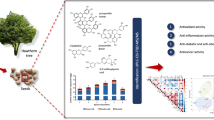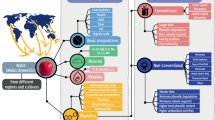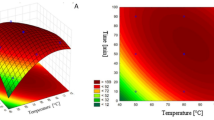Abstract
The fruits of two plants from Algeria (Quercus and Pistacia lentiscus) were investigated. The paper reports the chemical characteristics and the fatty acid composition of the oil extracts from the fruits. The black fruits of P. lentiscus has the highest crude fat of 32.8%, followed by the red fruits with 11.7%, and the lowest value of 9% in Quercus (acorn). The acid value was highest in red fruits of P. lentiscus oil (24.0 mg KOH/g), followed by the black fruits oil and lowest in acorn oil. The relatively high iodine value in the oils indicates the presence of many unsaturated bonds. Saponification value was highest in the Quercus ilex oil (166.7 mg KOH/g), while the lowest value was in the black fruits of P. lentiscus oil. Gas-liquid chromatography revealed that the three dominant fatty acids found are: palmitic C16:0 (16.3–19.5%), oleic C18:1 (55.3–64.9%), linoleic C18:2 (17.6–28.4%). The oils contain an appreciable amount of unsaturated fatty acids (78.8–83.5%).
Similar content being viewed by others
Avoid common mistakes on your manuscript.
Introduction
Pistacia lentiscus L.is an evergreen shrub of the Anacardiaceae family. This dioecious species can reach 3 m height and grows in arid areas. It typifies the Mediterranean region and it is commonly dispersed in Algeria over the entire littoral. The fruits, galls, resin and leaves of the P. lentiscus have a long tradition in folk medicine dating from the times of the ancient Greeks. It’s used in eczema treatment, paralysis, diarrhoea, throat infection, renal stones, jaundice, asthma and stomach-ache, and as astringent, anti-inflammatory, antipyretic, antibacterial, antiviral, pectoral and stimulant [1–4]. Fruits of P. lentiscus give an edible oil which is rich in unsaturated fatty acids as oleic and linoleic [5]. In Algeria the oil of the fruit is used by the population in traditional medicine in many ways, as an anti-diarrhoeal and also as constituent of cattle feed. Ample studies about the phytochemical composition of the resin, the leaves and the galls of the P. lentiscus have been carried out [6–9] but in contrast, fewer studies have been done to characterize the composition of the fruit oil [5].
The genus Quercus includes more than 300 species growing in temperate ecosystems. A lot of species of the Quercus are very characteristic of the Mediterranean area. Two species, Q. ilex L., Q. suber L., are characteristic of Algeria where the Quercus grows in the interior region of the country. The Quercus is considered as a fruit tree for the production of acorns to feed pigs. Meat products of such pigs are rich in oleic acid, making them healthier. They are also used to produce firewood and charcoal. The local population consumes the Quercus fruit and is also used as traditional local feed resource. The Quercus fruit is poor in protein but rich in starch and fat [10]. Although a detailed study of the lipid composition of three species of Quercus Spanish origin have been published [11], no studies have been done to characterize the oil composition of the acorn fruit of Algeria.
A better knowledge of the lipid composition of these fruits may lead to an enhanced new application of these fruits as a raw material for the synthesis of chemical or pharmaceutical products on the basis of the qualitative and quantitative composition of saponifiable and unsaponifiable matters. The aim of this work is to learn more about the fruits oils of P. lentiscus and Quercus in order to confirm results of previous works on the same species in other countries, and to compare them with those of other edible vegetables oils.
Experimental Procedures
Samples
Acorn fruits were provided by a local herbalist for each species included in the study, (Quercus ilex and Quercus suber), while P. lentiscus fruits were collected from three trees from Tipaza region in the north of Algeria. The fruits were divided in two groups according to the skin colors; black and red fruits. Oils were extracted from the whole fruit of P. lentiscus, while in the case of Quercus extraction was done after removing the hulls. For P. lentiscus and Quercus, the results of oil extract were the mean of three different samples collected randomly from the same region.
Fat Extraction
The seeds were milled into powder using a manual mill and extracted with hexane in soxhlet apparatus in order to determine the amount of oil in the fruits, followed by agitation at room temperature for 24 h for the different analysis. The extract was filtered and dehydrated with anhydrous sodium sulphate. The solvent was refiltered, evaporated under vacuum at 40 °C and the dried crude oil was kept in brown bottles at 6 °C.
Determination of the Chemical Properties of the Oils
Acid value, saponification value and the iodine value were determined in duplicate according to the procedure described by the AOCS [12].
Purification of Triglycerides(TAG)
To purify the neutral triglycerides fraction, 600 mg of the oil were filtered through a column made with 10 g of silica gel. TAG were eluted with 100 ml of benzene [13].
GC-MS Analysis of Fatty Acids Methylic Esters (FAMS)
FAME from the total oils or the purified TAG were prepared by acid catalysed esterification method using boron trifluoride–methanol complex 12% w/v. The analysis was performed in duplicate with an HP-5890 Series II chromatograph using a fused –silica capillary Carbowax column (60 m × 0.25 mm, 0.2 μm film thickness). The temperature programming was 120 °C for 2 min, then increased by 3 °C/min till 160 °C, kept for 20 min then increased by 1 °C till 180 °C, kept for 1 min then cooled. The injector temperature was held at 220 °C. Hydrogen was used as carrier gas. Mass Spectrometry(MS) conditions are electron –impact ionisation energy 70 eV, accelerating 4 kV, emission current 100 μA and ion source temperature of 200 °C. Each FAME present in the oil was identified by comparison of its retention time and mass spectrum with those of authentic compounds.
All experiments were carried out in triplicate unless otherwise stated; results are expressed as means ± SD.
Results and Discussion
Table 1 shows the determined amount of oil in the seeds and the chemical properties of the fruit oils extracted from P. lentiscus and Quercus. The crude fat content of the P. lentiscus fruit varied from 32.8% for black fruits to 11.70% red fruits (w/w). The amount extracted from the acorn was 9% (w/w) from the two species of Quercus, which is consistent with previous findings that reported an oil content of 7–10% [11, 14]. These results indicated that the black fruit of P. lentiscus can be considered as an oleaginous seed as in peanut, olive, sunflower and cotton seeds which possess (30–45% oil content) [15]. Although the acorn cannot be considered as an oil-bearing seed, its oil content was in the range of other vegetable materials that are used for their health components or their industrial or pharmaceutical applications, as in the case of wheat germs (less than 10% fat content)[16].
The acid value was high in the four oils and specifically in the red P. lentiscus fruit (24.0 mg KOH/g) which indicates that the oils contain a huge amount of free fatty acids. High values of the acidity in the oils are perhaps due to the bad conservation of the fruits before extraction and analysis or to the incomplete ripeness of the seeds. The relatively high iodine value in the four oils may be indicative of the presence of many unsaturated bonds and would certainly contain more unsaturated fatty acids and can thus be grouped as drying oils. Saponification values varied among in the oils and were highest in the Quercus (160.3–166.7 mg KOH/g); the lowest value was in red seeds oil of P. lentiscus (130.5 mg KOH/g). Because there is an inverse relationship between saponification value and weight of fatty acids in the oils, it can be assumed that the oils hold fatty acids with 16–18 carbon atoms with a significant amount of saturated fatty acids in the case of the P. lentiscus oil.
Except for the acid value, the chemical examinations of the oils as used in this study were in agreement with the other vegetables oils reported in the literature [15].
The FAME composition of the oils of the species is shown in Table 2. Seven fatty acids were identified in the seed oils. Individual percentages of each fatty acid are given in Table 2. The saturated fatty acids in the oils or triglycerides are palmitic and stearic; however palmitic acid was the major saturated fatty acid constituent, ranging from 16.3 to 19.5% in the oils and from 13.00 to 22.1% in the triglycerides of the oils. Stearic acid was detected in lower amount in the fruit oil of P. lentiscus only (0.7–1.7%).
Concerning the unsaturated acids, C18:1 and C18:2 were detected in all oils. C18:1 acid was determined to be the dominant fatty acids in the oils and TAG with 55.3–64.9% in the oils and 49.9–70.1% in the TAG. For the C18:2 acid the content was from 17.6–28.4% in the oils and 16.1–32.5% in the TAG. C18:2 acid was found only in the acorns seeds in very tiny amount that did not exceed 0.93% in the two oils. C16:1 acid was found only in two oils of P. lentiscus fruit with 1.0% in the red seed and 2.1% in the black one. However C20:1 acid was detected in the oil and TAG of Quercus suber species only. The content was ranged from 0.5–1.11% respectively.
The unsaturated fatty acids were predominant in all oils as confirmed by the iodine value test (78.6 and 109.0). However, the oleic acid was the main fatty acid in the present study. Oleic and linoleic acids are the major fatty acids reported in Spanish acorn oil (Quercus ssp) [11]. Also, our results for P. lentiscus fruit oil agree well with the data recorded by Ucciani in his dictionary [5].
Our study of the fatty acid composition in the acorn showed identical values for oleic acid in the olive oil. The monounsaturated fatty acids such as oleic acid have great importance because of their nutritional implication and effect on oxidative stability of oils [17].
The profile of fatty acids confirms the similarity between Quercus and P. lentiscus oils and other edible vegetable oils such as sunflower, peanut, cotton, olive and avocado. The unsaturated/saturated ratio (ratio of the sum of unsaturated FA to the sum of saturated FA) was generally high, and this high value gives these oils a good prevention of oxidation.
Based on our study, the seeds of P. lentiscus and Quercus are good sources of oil. The oils have similar but not identical fatty acid composition and contain a many amount of unsaturated fatty acids. Better knowledge on the composition properties of the seeds would assist in efforts to achieve industrial application of these plants. The data on chemical composition of the fruits should be useful for educational purposes and for compiling local food composition tables.
Further studies are needed for the valorisation of unsaponifiable matters in the oils of P. lentiscus and Quercus and also to determine composition of the amino acid and phenolic compounds.
References
Lev E, Amar Z (2000) Ethnopharmacological survey of traditional drugs sold in Israel at the end of the 20th century. J Ethnopharmacol 72:191–205
Lev E, Amar Z (2002) Ethnopharmacological survey of traditional drugs sold in the Kingdom of Jordan. J Ethnopharmacol 82:131–145
Ali-Shtayeh MS, Yaniv Z, Mahajna J (2000) Ethnobotanical survey in the Palestinian area: a classification of the healing potential of medicinal plants. J Ethnopharmacol 73:221–232
Said O, Khalil K, Fulder S, Azeizeh H (2002) Ethnopharmacological survey of medicinal herbs in Israel, the Golan Heights and the West Bank region. J Ethnopharmacol 83:251–265
Ucciani, E, Nouveau dictionnaire des Huiles Végétales—composition en acides gras. Technique et Documentation–Lavoisier. Paris, 1995
Castola V, Bigheli A, Casanova J (2000) Casanova, intraspecific chemical variability of the essential oil of Pistacia lentiscus L. from Corcica. Biochem Syst Ecol 28:79–88
Duru ME, Cakir A, Kordali S, Zengin H, Harmandar M, Izumi S, Hirat T (2003) Chemical composition and antifungal properties of essential oils of three. Pistacia Fitoterapia 74:170–176
Janakat S, Al-Merie H (2002) Evaluation of hepatoprotective effect of Pistacia lentiscus, Phillyrea latifolia and Nicotiana glauca. J Ethnopharmacol 83:135–138
Romani A, Pinelli P, Galardi C, Mulinacci N, Tattini M (2002) Identification and quantification of galloyl derivatives, flavonoid glycosides and anthocyanins in leaves of Pistacia lentiscus L. Phytochem Anal 13(2):79–86
Garcia Rebollo AJ, Macia Botejara E, Ortiz Canzado A, Morales Blanco PJ, Martin Bellido M, Fallola Sanchez A, Mena Arias P, Campilo Alvarez JE (1998) Effect of consumption of meat product rich in monounsaturated fatty acids (the ham from the Iberian pig) on plasma Lipids. Nutr Res 18:605–765
Leon-Camacho M, Viera-Alcaide I, Vicario IM (2004) Acorn (Quercus spp) fruit lipids: saponifiable and unsaponifiable fractions: a detailed study. J Am Oil Chem Soc 81:447–453
Official Methods and Recommended Practise of the American Oil (1993) Chemists’ Society, 4th edn. AOCS Press, Champaign, Methods Ce 2-66 and Ce 5b-89
Quinlin P, Herman J, Weiser JR (1958) Separation and determination of mono-, di-, and triglycrides in monoglyceride concentrates. J Am Oil Chem Soc 35:325–327
M’Hrit O, Benzyane M, Varrela MC (1998) Le chene–Liège au Maroc: Stratégie de Conservation et d’Amélioration. Ann Rech For Maroc (Special Issue):127–144
Karlenskind A (1992) Manuel des Corps Gras. Tome 1 Technique et Documentation. Lavoisier, Paris, pp 116–226
Sonntag NOV (1979) Composition and characteristics of individual fats and oils. In: Swern D (eds) Bailey’s industrial oil and fat products vol 1, Ath edn. Wiley, New York, pp 289–478
Aguilera MC, Ramirez-Tortosa MC, Mesa MD, Gil A (2000) Do MUFA and PUFA have beneficial effects on development of cardiovascular disease. In: Pandai SG (eds) Recent research developments in lipids (advances in lipid research), 369–390
Open Access
This article is distributed under the terms of the Creative Commons Attribution Noncommercial License which permits any noncommercial use, distribution, and reproduction in any medium, provided the original author(s) and source are credited.
Author information
Authors and Affiliations
Corresponding author
Rights and permissions
This article is published under an open access license. Please check the 'Copyright Information' section either on this page or in the PDF for details of this license and what re-use is permitted. If your intended use exceeds what is permitted by the license or if you are unable to locate the licence and re-use information, please contact the Rights and Permissions team.
About this article
Cite this article
Charef, M., Yousfi, M., Saidi, M. et al. Determination of the Fatty Acid Composition of Acorn (Quercus), Pistacia lentiscus Seeds Growing in Algeria. J Am Oil Chem Soc 85, 921–924 (2008). https://doi.org/10.1007/s11746-008-1283-1
Received:
Revised:
Accepted:
Published:
Issue Date:
DOI: https://doi.org/10.1007/s11746-008-1283-1




